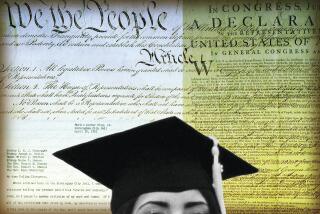Tougher High School Studies Urged : Bennett Paper Backs Course Requirements in Seven Core Subjects
WASHINGTON — Education Secretary William J. Bennett issued a report Tuesday that proposes a “broad, deep and effective” high school curriculum, a rigorous program that stresses high standards and details course requirements in seven core subjects.
“Our children should know about continental shift and quadratic equations, about Gothic architecture and the Gettysburg Address, about what a symphony is and about who Shakespeare was and what he wrote,” Bennett said at a press conference. He stressed that his plan is “for the students we have, not for an imaginary class of teen-age wizards.”
Bennett’s blueprint, which outlines a curriculum for an imaginary James Madison High School, was based on a 1983 report by the National Commission on Excellence in Education. The controversial report, “A Nation At Risk,” decried overemphasis on non-required courses and called for four years of English and three years each of social studies, math and science.
More Requirements Urged
The curriculum would go even further in Bennett’s fictional school, adding required courses in three more core subjects: foreign languages, physical education-health and fine arts. James Madison students would be required to take two years of foreign language and physical education, as well as a semester each of art and music under the fine-arts category.
In all, the students would take 36 courses in core subjects. Non-required courses, or electives, would compose only a quarter to a third of their classroom time.
The model school “is meant as a goal and an ideal, not as a monolithic program to be uniformly imposed or slavishly followed,” Bennett wrote in his report, which he said was not a statement of federal policy.
Bennett said only about 15% of high schools offer the sort of curriculum he proposed. He cited seven high schools that had what he considered excellent curricula, including James A. Garfield High School in Los Angeles, which recently ranked seventh nationally in the number of students passing the Educational Testing Service’s advanced placement calculus test.
Bennett’s Recommendations
The secretary said his recommendations reflect his judgment about what every student should know. His required courses include:
--An introduction to literature for ninth-graders limited to “recognized masterworks of Western literature,” including Homer’s Odyssey, Shakespeare’s plays and the Bible; American literature for 10th-graders; British literature for juniors, and world literature for seniors, including classical and European works.
--Three years of math drawn from a selection including geometry, algebra I and II, statistics and calculus.
--Three years of science drawn from a list that includes astronomy, geology, biology, chemistry, physics and the principles of technology.
--Western civilization for ninth-graders, American history for 10th-graders and two-semester American democracy courses for juniors.
--Instruction about “the dangers of alcohol and drugs” and a sex education unit taught “in an open, serious and moral context, emphasizing restraint and the importance of the family.”
In California, state and local education officials said they welcomed Bennett’s statement and his use of Garfield High as a positive example. However, they stressed that many of his proposals already are in place at most schools here.
“What he is suggesting affirms to us what we’ve been doing in California,” Bill Honig, state superintendent of public instruction, said in a telephone interview. “We basically bought the argument and have done something about it in a major way.”
Honig said he hoped that the federal and state governments would follow up with more funding to improve staffing and to cut the number of students in each class.
California Requirements
Under reform measures passed in 1983 and phased in through last year, California students are required to take three years of English, two years of mathematics, two years of science, three years of history or social science, two years of physical education and one year of either a foreign language or fine arts, Honig said.
However, the state also has set higher targets for tougher course loads, which California students are exceeding in most categories, Honig said. A state survey of 12th-graders last year showed that 90% had taken four years of English, 82% had at least three years of mathematics, 53% had three or more years of sciences, 43% had four years of history or social sciences, 27% had at least three years of a foreign language and 75% had a year of fine arts.
Bill Rivera, spokesman for the Los Angeles Unified School District, said: “Of course, we are proud and delighted that he picked Garfield, but the graduation requirements at Garfield are surely the same at the 48 other high schools in the city. And while we like to think we move more aggressively, I don’t think our district is atypical in the nation.”
Times education writer Larry Gordon contributed to this story.
More to Read
Sign up for Essential California
The most important California stories and recommendations in your inbox every morning.
You may occasionally receive promotional content from the Los Angeles Times.









